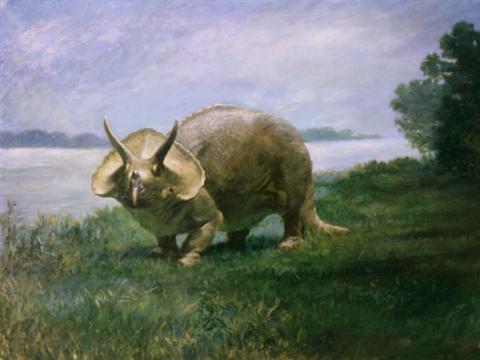
Sara's teeth © Emily Bamforth / Redpath Museum
Strict vegetarians,
Triceratops needed to do more than nibble on a leaf or two to reach and maintain their adult weight of 3-5 tonnes. They used their powerful beaks, specialized teeth and immense jaw muscles to eat entire trees – trunk and all.
During the late Cretaceous period, when Triceratops such as Sara roamed the Earth, their diet consisted mainly of angiosperms (flowering plants). How do we know?

A Triceratops tooth © Emily Bamforth / Redpath Museum
Along with dinosaur bones, palaeontologists find fossilized plant matter – leaves, seeds, and twigs – preserved in sedimentary rock. Plant fossils provide an excellent record of life in past times because plants are very sensitive to their immediate environment. Areas of distribution and population patterns of plants tell us a lot about climatic conditions and the ecosystem as a whole.
It was during the Cretaceous period (about 124 million years ago) that non-flowering plants, such as conifers and cycads, started to lose ground as the predominant form of vegetation on Earth, and some of these species even became extinct. At the same time, flowering plants (angiosperms) were on the rise and, before long, around 250,000 species of angiosperm dominated the plant world.

Plantanus acerifolia (plane tree or sycamore)
Angiosperms (from the Greek
angio – ‘vessel’ and
sperma – ‘seed’) include all flowering plants with distinct seeds that enlarge into a fruit once fertilized. Flowers give angiosperms greater capacity to evolve and adapt because they attract insects and vertebrates as pollinators. This creates a co-evolving system between plants and the animals around them, generating ever-increasing diversity.

Viburnum plicatum mariesii (Japanese snowball shrub)
may have played a role as a pollinator for angiosperm plants, enjoying a varied diet of fruits, seeds, leaves, twigs and roots. However, unlike modern herbivores,
Triceratops would not have eaten grass as grasses did not evolve until the Cenozoic era, after the extinction of the dinosaurs.
Some plants that Sara would have munched on include:
- Populus – poplars
- Pinus – pines
- Corylus – a hazelnut shrub from the filbert genus
- Taxodium – cypress trees
- Plantanus – sycamores or plane trees







